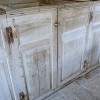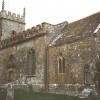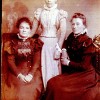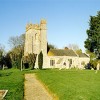Hidden away off the beaten track about three miles south of Sherborne is the small and entirely rural parish of Lillington. It lacks all but the basic amenities but still has a place of worship – the Parish Church of St. Martin. I was visiting the village in search of a baptism record dating back nearly two hundred years and found the entry I was looking for in the church register, which is still in use today.
Lillington is home to about 80 people, approximately half that of the population recorded in the 1851cenus; figures that explain why it will be a few years yet before the church register moves to Dorchester to enjoy retirement on the shelves of the Archive Service. In 1851 the Loader family accounted for a third of the residents with the Banger; Bartlett; Bow; Dunford; Jeanes; King; Mash; Mitchell and White families all present here as well.
At the north end of the parish the church is a close neighbour of the old barn, once a part of Manor Farm and in recent times tastefully converted for residential use. The medieval fishpond is nowadays inhabited by ducks and can be viewed from St. Martins. A decade into the reign of Queen Victoria saw the parishioners planning restoration works for their 13th century church and a year later in 1848 work started under the supervision of Withers of Sherborne.
St. Martins is built with local rubble and faced with the same material; roofs are covered with stone slates and the interior is plastered and finished with a traditional lime wash. It comprises: chancel, nave, west tower, south chapel with entry by way of the north porch. The south door was blocked off during the Victorian restoration because of the access it allowed to a penetrating draft from the prevailing weather. The parishioners at that time installed a furnace outside of the church that provided an early form of under floor heating; the air ducts can still be seen under the door mats in the north porch. The upper part of what was the south door is now a window with a piscina in the recess.
The tower, added in the 15th century, is of three stages, topped off with an embattled parapet with gargoyles and pinnacles. There is a square stair turret on the north wall leading up to the belfry which houses five bells; the oldest is c.1400, the belfry windows are of two lights. The west window above the tower door is of three lights and in the south wall of the centre stage there is a window of two lights.
The narrow late 13th century nave allows for a four seat pew on either side of the central aisle and has a 15th century pointed wagon ceiling with plastered panels, moulded ribs and carved bosses. The present surveyor responsible for the church has been heard to wonder aloud why Mr. Withers overlooked to provide an access point to the void above the ceiling. In the north wall of the nave, east of the porch, is a 15th century three light window with hood mould and perpendicular tracery and there is a small rectangular window west of the porch. In the south wall of the nave is a 13th century two-light window.
At the west end of the nave is the font: octagonal bowl with quatrefoiled panel in each face enclosing shields and roses alternately, on an octagonal stem, of the 15th century.
You enter into the nave from the north porch which has a 17th century round arched doorway. The inner doorway has a pointed arch and a 15th century oak door. Directly opposite is the south chapel added in the 18th century with south and east windows that look quite modern. From the south window you can look out across the churchyard to the pond. George Hamilton Fletcher of Leweston Manor lost his son Gareth a 2nd Lieut. in the Grenadier Guards and his son-in-law Laurence R. Fisher-Rome a Lt. Col from the same regiment; both men were killed in France during the early months of 1915. They are remembered by a memorial on the west wall of the chapel.
During the 15th century the chancel was rebuilt and the east window of two lights with perpendicular tracery has been restored possibly in recent times; certainly the story depicted in the window is modern, possibly a war memorial. The chancel benefits from windows in the north and south walls both of the 15th century and both of two lights. The chancel has a plastered pointed barrel ceiling; the arch is later, probably 18th century.
Monuments within the church and outside in the churchyard include mention of Thomas Gollop and his wife Jane 1824; Thomas Gollop 1793; Samuel Whetcombe 1739 and his son Robert 1737; Edward Jeffrey 1712; Dorothy, wife of Edward Jeffrey Sen., 1705; Nekles Riol and his wife Allse 1693; George Hankins 1671 and Frances, his wife, 1696; Ralph and Thomas Gollop with defaced shield-of-arms, date uncertain but definitely 18th century; Lawrence Cole 1669; and Mary Parry 1708.
St. Martins is a small, attractive rural church part of the Benefice of Sherborne and services continue to be held every Sunday throughout the year but the church is locked at other times. We thank Mrs. Messenger, the churchwarden, for allowing us to inspect the registers, showing us around, and allowing us to take some photographs inside the building.



